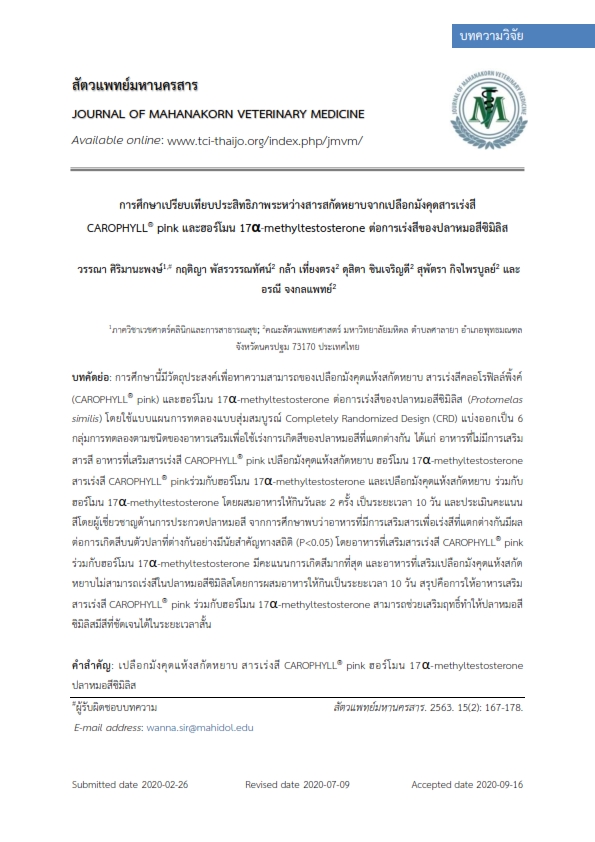Comparison of Color Enhancement Efficacy in the Ornamental Cichlid Protomelas similis between Using CAROPHYLL® pink, Mangosteens Pericarp Crude Extract, and 17α-methyltestosterone Hormone
Main Article Content
Abstract
The aim of this experiment was study the efficacy of color enhancement mangosteen pericarp crude extract, color enhancing CAROPHYLL® pink and 17α-methyltestosterone hormone on color skin of Protomelas similis. The experimental design was a Completely Randomized Design (CRD) of 6 treatments follow as types of supplementation feed for color enhancement in P. similis (control feed, feed supplement with CAROPHYLL® pink, mangosteen pericarp crude extract, 17α-methyltestosterone hormone, 17α-methyltestosterone hormone plus CAROPHYLL® pink and 17α-methyltestosterone hormone plus mangosteen pericarp crude extract). P. similis were fed by these feeding program and then were evaluated color scoring by expert who had experience about cichlid contests. From this study, found that the different color enhancing feed groups had significantly effect on P. similis skin color (P<0.05) which P. similis that were fed 2 times a day for 10days by 17α-methyltestosterone hormone plus CAROPHYLL® pink had highest color score. However, P. similis were fed with mangosteen pericarp crude extract didn’t show different color enhancing feed groups compared to the control group within 10 days (P>0.05). The combination between 17α-methyltestosterone hormone and CAROPHYLL® pink in the feed help to P. similis express skin color in short term.
Article Details
References
Ambati, R. R., S. M. Phang, S. Ravi, and R. G. Aswathanarayana. 2014. Astaxanthin: sources, extraction, stability, biological activities and its commercial applications a review. Mar. drugs. 12(1): 128-152.
Baron, M., S. Davies, L. Alexander, D. Snellgrove, and K. Sloman. 2008. The effect of dietary pigments on the coloration and behaviour of flame-red dwarf gourami. Colisa. lalia. Anim. Behav. 75(3): 1041-1051.
Biabani, A. M., M. Sudagar, N. Shahraki, and S. Vahdat. 2019. Effect of extracted phycocyanin from Spirulina platensison growth parameters, colorations, digestive enzymes and body chemical compositions of Guppy fish (Poecilia reticulata). J. Sur. Fish. Sci. 6(1): 1-8.
Chaovanalikit, A., A. Mingmuang, T. Kitbunluewit, N. Choldumrongkool, J. Sondee, and S. Chupratum. 2012. Anthocyanin and total phenolics content of mangosteen and effect of processing on the quality of mangosteen products. Int. Food Res. J. 19(3): 1047-1053.
Chen, X. J., W. Li, Y. Y. Zhu, and Q. Wang. 2018. Effect of methyl testosterone on the body color of Chinese bitterling (Rhodeus sinensi). Pak. J. Agri. Sci. 55(2): 417-422.
European Food Safety Authority (EFSA). 2014. Scientific Opinion on the safety and efficacy of astaxanthin (CAROPHYLL® Pink 10% CWS) for salmonids and ornamental fish. EFSA J. 12(6): 3725-3758.
Goda, M., Y. Fujiyoshi, M. Sugimoto, and R. Fujii. 2013. Novel dichromatic chromatophores in the integument of the mandarin fish Synchiropus splendidus. Biol. Bull. 224(1): 14-17.
Hickman, C. P., L. Roberts, and A. Larson. 1993. Integrated principles of zoology. 9th ed. Mosby. St. Louis. 905 p.
Jiang, J., W. Nuez-Ortin, A. Angell, C. Zeng, R. de Nys, and M. J. Vucko. 2019. Enhancing the colouration of the marine ornamental fish Pseudochromis fridmani using natural and synthetic sources of astaxanthin. Algal. Res. 42: 101596. https://doi.org/10.1016/j.algal.2019.101596.
Karsli, Z., D. Şahin, M. Öz, and O., Aral. 2018. The effect of hormone (17α-methyl testosterone, 17β-estradiol) usage on development, sex inversion and pigmentation of electric yellow cichlid (Labidochromis caeruleus Fryer, 1956). Appl. Ecol. Env. Res. 16(6): 8093-8103.
Korzan, W. J., R. R. Robison, S. Zhao, and R. D. Fernald. 2008. Color change as a potential behavioral strategy. Horm. Behav. 54(3): 463-470.
Kurnia, A., I. Nur, W. H. Muskita, M. Hamzah, W. Iba, R. S. Patadjai, A. M. Balubi, and N. Kalidupa. 2019. Improving skin coloration of koi carp (Cyprinus carpio) fed with red dragon fruit peel meal. Aquac. Aqua. Conserv. Legis. Biof. 12(4): 1045-1053.
Lorenz, R. T. and G. R. Cysewski. 2000. Commercial potential for Haematococcus microalgae as a natural source of astaxanthin. Trends. Biotechnol. 18(4): 160-167.
Monica, J., N. Vyjayanthi, and D. Seenappa. 2019. Effect of dietary incorporation of anthocyanin pigments on the coloration and growth of orange swordtail fish (Xiphophorus helleri). Int. J. Fish. Aqua. Stud. 7(5): 144-149.
Nurhadi, T., W. Lili, R.I. Pratama, and K. Haetami. 2019. Effects of Astaxanthin and Canthaxanthin Addition to Ranchu Goldfish (Carassius auratus) Diet Related to Rate of Color Quality Enhancement. World. News. Nat. Sci. 24: 178-183.
Pérez-Escalante, V., G. Aguirre-Guzmán, P. E. Vanegas-Espinoza, and A. A. Del Villar-Martínez. 2012. Effect of Anthocyanin’s Extract from flour of Roselle calyx (Hibiscus sabdariffa) on growth and pigmentation of Goldfish (Carassius auratus). Thai. J. Vet. Med. 42(1): 107-111.
Rahim, M. A., N. Busatto, and L.Trainotti. 2014. Regulation of anthocyanin biosynthesis in peach fruits. Planta. 240(5): 913-929.
Sefc, K. M., A. C. Brown, and E. D. Clotfelter. 2014. Carotenoid-based coloration in cichlid fishes. Comp. Biochem. Physiol. A Mol. Integr. Physiol. 173(100): 42-51.
Seymour, E. M., S. M. Warber, A. Kirakosyan, K. R. Noon, B. Gillespie, V. E. Uhley, J. Wunder, D. E. Urcuyo, P. B. Kaufman, and S. F. Bolling. 2014. Anthocyanin pharmaco kinetics and dose-dependent plasma antioxidant pharmacodynamics following whole tart cherry intake in healthy humans. J. Funct. Food. 11: 509-516.
Shahidian, M., S. Fatemi, I. Sharifpour, A. Mashinchian, and S. Kakoolaki. 2012. Effects of 17 α-methyl testrosterone on the secondary sex characteristics in the scat (Sarcophagus argues) J. Mar. Sci. Technol. Res. 7(1): 67-73.
Stauffer Jr., J. R., K. Black, M. Geerts, A. Konings, and K. McKaye. 2006. Cichlid fish diversity and speciation, In: Reconstructing the Tree of Life: Taxonomy and Systematics of Species Rich Taxa. 1st ed. Hodkinmson, T.R. and J. A. N. Parnell. CRC Press. London. 213-225 p.
Wrolstad, R. E., R. W. Durst, and J. Lee. 2005. Tracking color and pigment changes in anthocyanin products. Trends. Food. Sci. Technol. 16(9): 423-428.
Yamazaki, F. 1983. Sex control and manipulation in fish. Aquaculture. 33(1-4): 329-354.
Yeşilayer, N., O. Aral, Z. Karsli, M. Öz, A. Karaçuha, and F. Yağci 2011. The effects of different carotenoid sources on skin pigmentation of Goldfish (Carassius auratus). Israel. J. Agr. Res. 63: 1-9.


